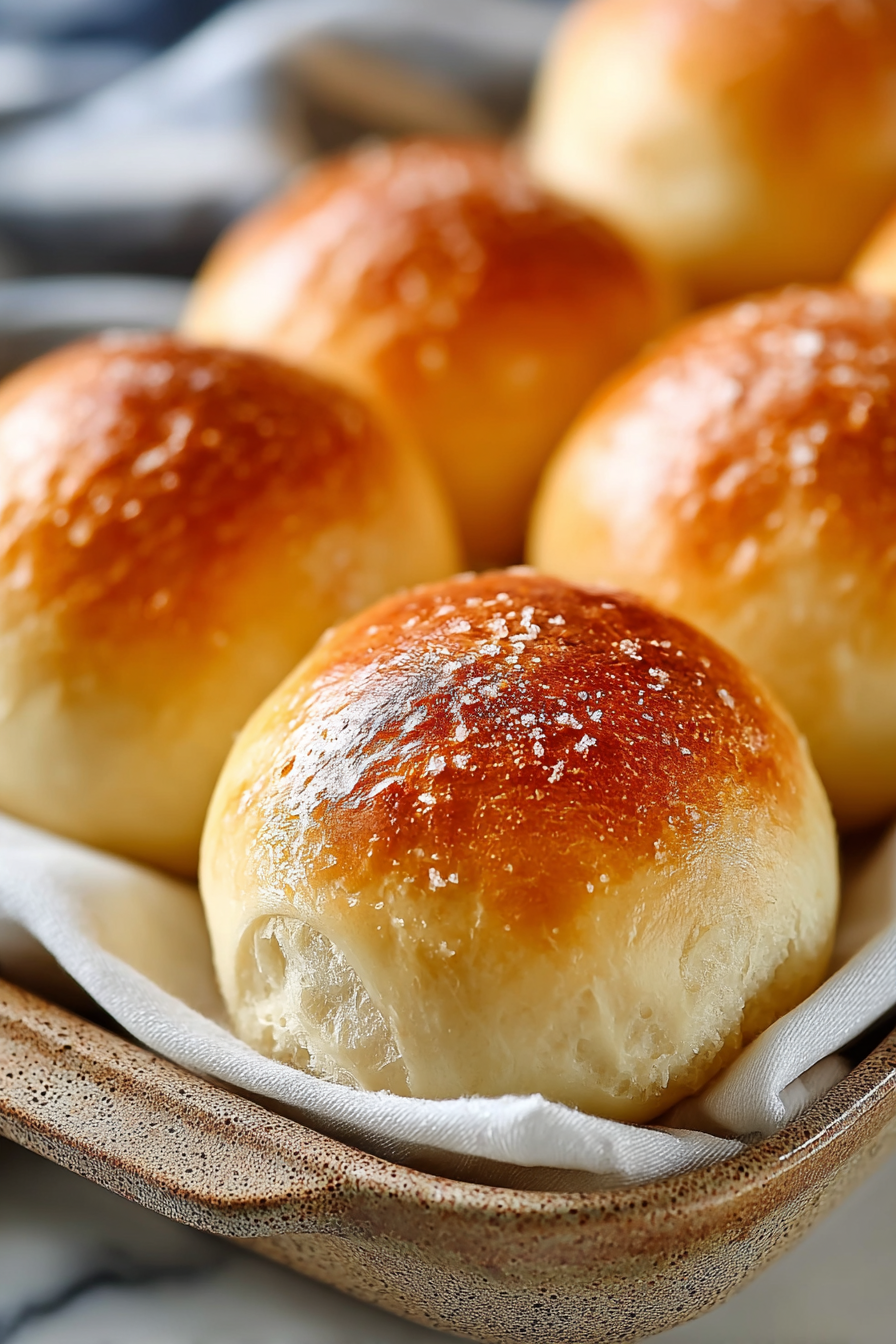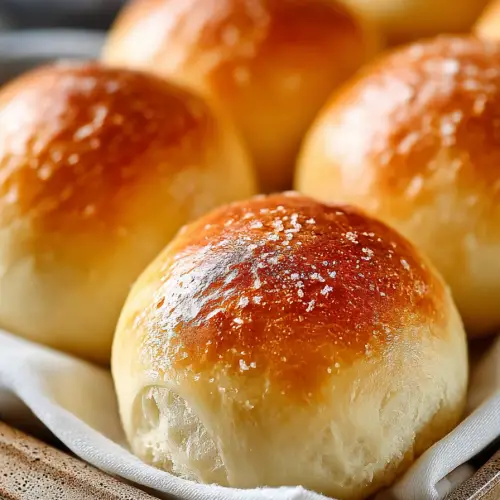Easy French Bread Rolls Recipe

I make these rolls on a slow Saturday morning, when the light slips across the counter and everything feels like it could be forgiven. They’re simple—honestly, that’s the charm—Warm, crusty on the outside, pillowy and tender inside, with that faint toasty scent that drifts down the hallway and gathers everyone at the kitchen doorway. If you’ve been looking for an Easy French Bread Rolls Recipe that fills the house with comfort and takes the pressure off, these are it: forgiving, satisfying, and small enough to share without ceremony.
There’s a particular kind of pleasure in shaping little loaves with your hands. I’ll admit I’m a bit slow about it; I take the time to press the dough, feel the texture, and sometimes I let my toddler press one too—then we both laugh when the shape becomes more art than bread. The dog pads in and sits by the oven like it’s waiting for the world to make good. I have a half-drunk mug of coffee on the sill, cooling into something dark and honest, and soft music plays low. When the rolls come out, the crust sings with a gentle crackle as I pull them apart, steam curling up and catching the light. Butter meets warm crumb, and for a few minutes, the house smells like a bakery we somehow own.
MORE OF OUR FAVORITE…
Share a soft story about how your husband or little family enjoys this dish. Keep it tender and homey, like a memory you’d tell over coffee. Feel free to describe the kitchen scene — morning light, quiet music, weekend chatter.
My husband is the sort of person who will butter his roll and then, with an air of great ceremony, hand it to our son to taste first. He pretends it’s a formal inspection, raising an eyebrow as if the roll might reveal its secrets. Our son, flour smudged on his cheek, takes a bite and declares it “perfect,” which to him means mostly that it’s fluffy and lets him smear jam without it collapsing. There was one Sunday when I under-salted the dough—an honest oversight—and my husband refused to be dramatic, he just fetched flaky sea salt from the jar and sprinkled it across the top like some small, saving ritual. We ate those rolls with raspberry jam and thick-cut bacon, the dog nosing near our knees for crumbs, and somehow that little mistake made the moment softer, because it turned into this tiny teamwork: a shared fix, a shared laugh.
Why You’ll Love This Easy French Bread Rolls Recipe
– They feel effortlessly special. The crust has that satisfying whisper when you break one open, and the interior is pillowy, tender, and just moist enough to make butter melt into it like sunlight.
– They’re adaptable. You can make them for a weekday supper and they still feel like a treat, or stretch them into a weekend ritual with coffee and slow conversation.
– They carry scents that feel like home: warm wheat, a hint of toasty caramel where the crust darkens, and that yeasty, comforting note that tells you someone loved the process.
– They’re hands-on in the best way—quiet, tactile work that lets your brain unwind while your hands do simple, honest things. Kneading, shaping, the waiting folds into a pleasant kind of patience.
Slow Moments
There’s a rhythm to making these that I savor. You start with a quiet bench, a dusting of flour, and a playlist that travels through calm songs. I sip coffee slowly between stretches of folding dough, sometimes wiping a smear of sticky flour on my apron and thinking about nothing important. When the dough rests, the house hums with small life: the baby’s breath behind closed doors, my husband flipping through a cookbook, the dog curling into a sunbeam. Waiting is part of the recipe—the pause where the dough transforms—and I love that pause. It makes the final warm-out-of-the-oven moment feel like a gentle reveal, as if the house is leaning in together to see what we made.
Time-Saving Hacks
– Let the dough rise in a warm spot while you get other things done—dishes, a quick tidy, or setting the table. Ten extra minutes of rise tends to pay off in texture.
– Shape smaller rolls for faster baking if you’re short on time; they brown quicker and still deliver that soft interior.
– Use a stand mixer for the kneading if you have one, and then switch back to hands for the shaping. The machine does the heavy lifting, but your hands give the final personality.
– Par-bake and freeze: if you make double batches, freeze the second batch after the first bake and reheat gently when you need them. It’s not “instant,” but it’s a cozy convenience.
– A calm reminder: rushing the rise or skipping a gentle fold can change the crumb. Slow often improves flavor more than faster ever could.
Serving Ideas
– Weeknight comfort: split a warm roll, slather with butter, and pair with a bowl of tomato soup or a simple weeknight stew. It’s homey, quick, and filling without fuss.
– Weekend splurge: set the rolls on the table with softened butter, fruit preserves, and a little dish of honey or olive oil for dipping. Add soft scrambled eggs and smoky sausages for a lazy brunch that lingers.
– For lunches: these rolls make lovely sandwich vessels—think roast turkey with crisp greens and mustard, or a simple caprese with ripe tomato and basil.
– Drinks: coffee is my default in the morning; in the evenings, a light white wine or an herbal tea feels right.
– If you like a companion recipe, the image I use on the blog pairs well with any gentle salad or soup; it’s the kind of roll that meets other simple dishes and elevates them.
Tips & Mistakes
Be gentle with the dough and with yourself. I once overworked a batch because I read something that made me nervous; the rolls came out drier and denser than I like. The fix was simple: a little extra moisture and a softer touch on the next go. Watch your oven—what’s “golden” to some is “too dark” to others—so trust your nose as much as your clock. If the crust is forming too fast, tent with foil for a part of the bake. If you’re new to shaping, don’t worry about perfection; rustic little buns are charming, and kids love them best when they’re a bit squishy.
Storage Tips
Leftovers keep nicely for a day or two wrapped in a cloth or in a paper bag—this keeps the crust friendly instead of leathery. For longer storage, slice and freeze; you can toast them straight from frozen for a quick breakfast. Reheating in a low oven with a touch of moisture (a spritz of water or a damp towel) brings back a lot of that just-baked feeling. Cold, they’re comforting with coffee for a quiet morning nibble, or warmed and buttered for a lunch that feels like a caring note to yourself.
Variations and Substitutions
I’ve added a few things over time with good results. A sprinkle of herbs on top—thyme or rosemary—gives a savory note that’s lovely with soups. A handful of whole wheat or spelt flour swaps in easily for some of the white flour for a nuttier flavor, though the texture shifts a touch. I once tried adding cheese into the dough; it was delicious but a little denser, so I reserve that for when I want a heartier roll. Citrus zest in the dough surprised me once and added a bright lift for a brunch-focused batch; my husband raised an amused eyebrow but ate three anyway.

Frequently Asked Questions
If you try these rolls, take a deep breath while they’re in the oven. There’s a small, gentle joy in giving yourself permission to slow down a little. Pass one to someone you love and listen to the quiet conversation that starts—the kind that happens around simple food and soft light.

Easy French Bread Rolls Recipe
Ingredients
Main Ingredients
- 4 cups all-purpose flour
- 1 packet active dry yeast
- 1 tablespoon sugar
- 1.5 cups warm water 110°F
- 2 teaspoons salt
- 2 tablespoons unsalted butter melted
Instructions
Preparation Steps
- In a large bowl, mix warm water, yeast, and sugar. Let it sit for 10 minutes until frothy.
- Add flour, salt, and melted butter to the yeast mixture. Mix until a dough forms.
- Knead the dough on a floured surface for about 5-7 minutes until smooth.
- Place the dough in a greased bowl, cover with a cloth, and let it rise for 1 hour until doubled in size.
- Punch down the dough, divide it into 12 equal pieces, and shape into rolls.
- Place rolls on a baking sheet, cover, and let them rise for another 30 minutes.
- Preheat the oven to 375°F and bake for 20-25 minutes until golden brown.
- Remove from oven, cool on a wire rack, and enjoy with butter.
